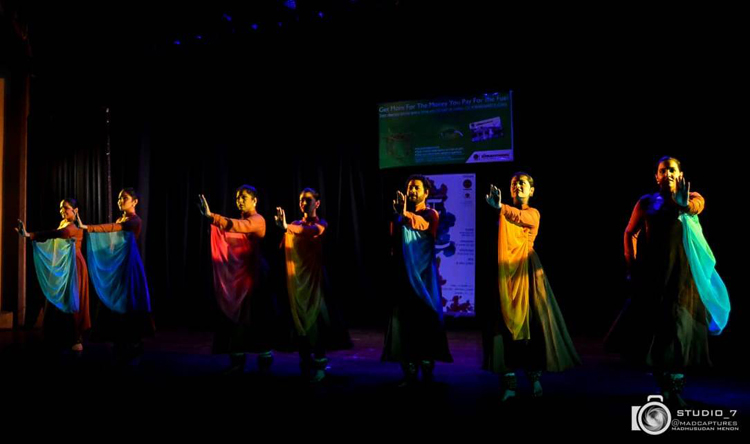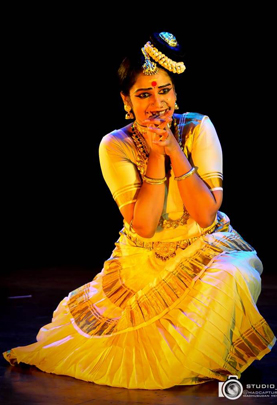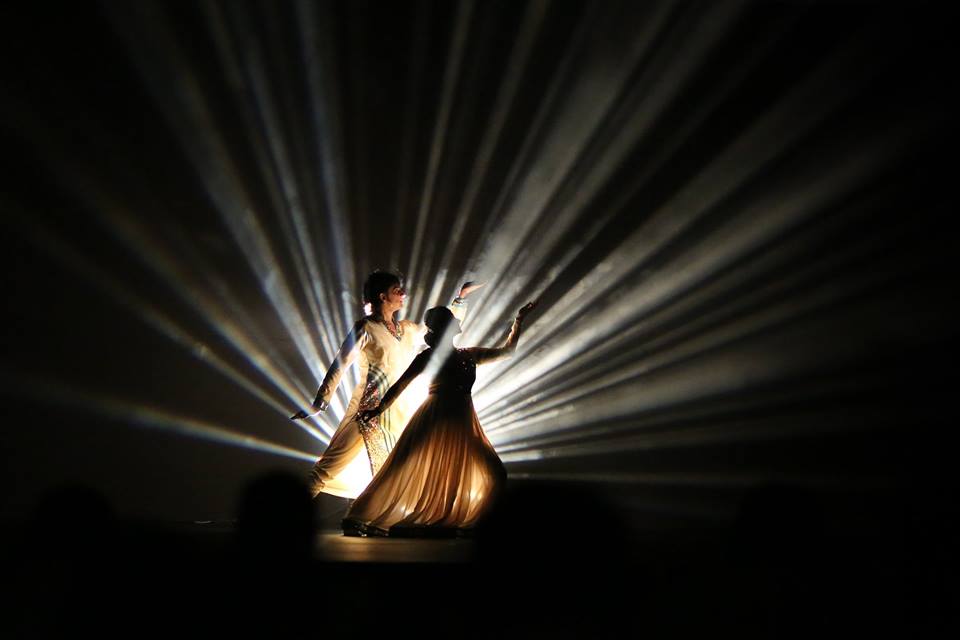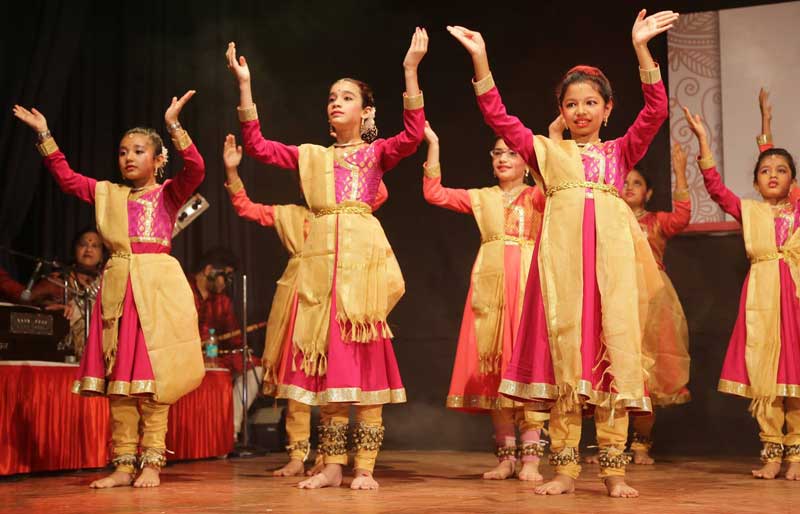Of the five senses, the one that gives us the maximum stimuli at any moment is that of sight. Colour is that tangible stimulus that resonates with the ‘bhava’ within and at the same time leaves impressions on both the memory and intellect. In collaboration with the NCPA Mumbai Dance Season, Manas Cultural Trust organized ‘Rang’ an evening that highlighted the perception of colour in choreography, presented in the twin languages of Mumbai-Marathi and Hindi. Kathak exponent Manisha Jeet and her disciples along with Bharatanatyam stalwart Kalashri Lata Surendra, Mohiniattam danseuse Sujatha Nair and Chhau exponent Ankit Pahadia wove together an action-packed hour of colour and choreography that seamlessly blended together in thought, approach and excellence of execution.

The opening poetic piece Pratyek Rangachi Ek Kahani, Pratyek Kahani Cha Ek rang (every colour has a story, every story its own colour), presented by Manisha Jeet and her disciples set the perfect mood for the rest of the evening. The first colour presented was white, representing the season of winter-Shishir. Combining verses of Kalidas’s Ritu Samhara with original kavitt’s the music at once brought about the magnificence of a white winter while simultaneous conveying the human need of wanting winter to pass as soon as possible using the gravitas of dhrupad based music combined with the fleeting overtones of xylophonic sounds. Kathak often employs metaphorical thought known as ‘misaal ka bhaav’ and Manisha employed that perfectly with an apt comparison of Ahalya to the stony Himalayas as they both wait for the graceful touch of the divine.

This was followed by Mohiniattam by Sujatha Nair, who is one of Mumbai’s most versatile soloists. Daughter and disciple of Jayashree Nair, the mother-daughter duo always bring to stage subtle and innovate choreography, distilled through spot-on anga shuddi, which is a hallmark of Sujatha’s performances. Sujatha presented the colour of love ‘Pink’ through two stories. She began with a unique Marathi composition written by Sarfoji Bhosale ‘Kaun Kewad Ughadto?’(Who is it that opens the door?). This humorous piece depicted Parvati teasing Shiva, as she feigns ignorance of his identity. She points out all the dangerous attributes excited by him, as an unknown person draped in ash and snakes and seemingly drinking poison. Shiva, on the other hand, tries to convince her that he is but the graceful dancer who had won over her heart, to begin with. While Parvati carries on this charade, Shiva loses his temper. That is when Parvati knows that she has to let go of the charade and placate him letting him into the house. While this piece looked at ‘hasya’ which is an integral aspect of Shringara, Sujatha’s second piece in Hindi touched upon adamancy, which sometimes becomes a part of lover’s dialogue. ‘Chaliye Kunjan’ –let us go to the forest cajoles the gopika, while Krishna knowingly fuels her desire, while at the same time tricking her away from the forest. Sujatha conveyed the hidden desire and love of the gopika with mastery as the audience became engrossed in finding out how this story ends. In the climax, Sujata leads the audience from the journey of physical love to that of Bhakti, where the colour pink merges with the all-pervading colour of divinity.
The next two colours green signifying Islam and saffron signifying Maratha fervour were presented by Manisha and her disciples highlighting the syncretic nature of Kathak. The story of Haji Ali was brought to life through a poignant Hindi poetry (kisi duur galiyon se aaya woh farishta) set to choreography that emulated the waves of the ocean and the movement of sand dunes. The central story was a popular episode where Haji Ali helps a woman extract oil from the correct location on the shore and then later is faced with grief over injuring mother earth. A strong message that is especially true today when overuse of nature has lead to adverse effects globally. The flowing music with Persian influences created a soothing palette for Manisha’s choreography that highlighted how nritya in a group could be effectively used to convey an emotion. In contrast, was the high energy and fervor filled piece dedicated to the Kesari colour using the poetry of Kavi Bhushan that compared Shivaji’s victory over Mughals to that of Krishna over Kans, Ram over Raavan and other such epic victories of good over evil.
[adrotate group=”9″]
The next colour was that of spring- Yellow in conjugation with that of the cosmos-Black brought to life by Kalashri Lata Surendra. The womb, where life is nurtured is black and so also the colour of the golden devi when she takes her ferocious avatar to protect her children. Lata Surendra presented the story of Ganesh Nirmetee in a combination of energy-filled nritta and heart-wrenching abhinaya that conveyed sadness and anger that Parvati is consumed by upon seeing the severed body of her beautiful child, one that she herself created from the golden turmeric and sandal paste on the body.

Lata Surendra often defies notions of age and time as her performance carries the energy of a body quarter of her age juxtaposed simultaneously with ancient wisdom and modern-day wit. In the fight between Shiva and Sukumara, she depicted the divine arrogance of Shiva on one side and the childish arrogance of the child on the other side so masterfully that the audience did not know whose side to be on, but just ponder over the helplessness of the situation. The grieving mother invoking the devi within was effectively depicted using ‘ya devi sarva bhuteshu’, in an ode to all mothers, who are simultaneously nurturing and warrior-like when it comes to protecting their children. The climax with Tulsidas’s ‘Gayiye Ganapati Jag Vandana’ brought instant happiness to the audience especially to see unfold the dance of Ganesha. A special mention must be made for the powerful music that supported Lata Surendra throughout the piece.
The next colour Blue was presented by Manisha and her disciples. Manisha interpreted blue as a colour of freedom in resonance with the colour of the sky. In a time today when Bollywood and Kathak are coming together both in favourable and unfavourable ways, Manisha showed how one can stay within the framework of Kathak and yet connect with popular music. Using the refrain of the popular Shubha Mudgal song ‘Mann ke Manjeere’ Manisha presented original poetry written by her that depicted the journey of a woman breaking the bonds of oppression and dancing forth to a bright future.
[adrotate group=”9″]
This was followed by the concluding piece based on the colour of blood -Red that brought to life the fight of Abhimanyu in the chakravuh on Kurukshetra. Chhau Artist Ankit Pahadia portrayed the role of Abhimanyu supported by Manisha’s students. The Kathak canvas created by her students was perfect to highlight the utplavanas and mandalas that are a signature of Mayurbhanj Chhau. Ankit did justice to the role with his energy and abhinaya and made the whole scene believable for the audience. The piece was left with Abhimanyu still fighting, leaving the audience with the hope that maybe another ending would someday be possible for the Abhimanyu’s in the wars of today.
The curtain call was a beautiful abhang written by Saint Soyaraabai, ‘Avghaa Rang Ek Zala’ where all the dancers of the evening came together to unite as one, with all the colours of the evening merging together into one colour, one painting, one DANCE.










